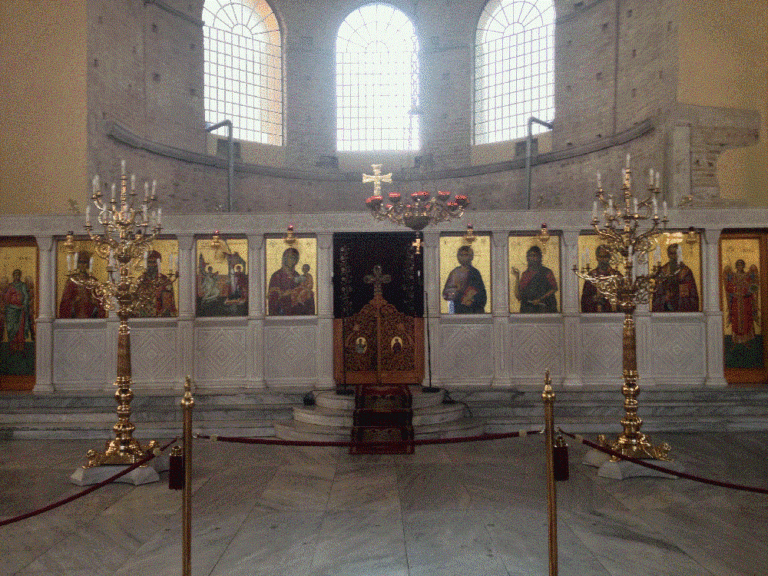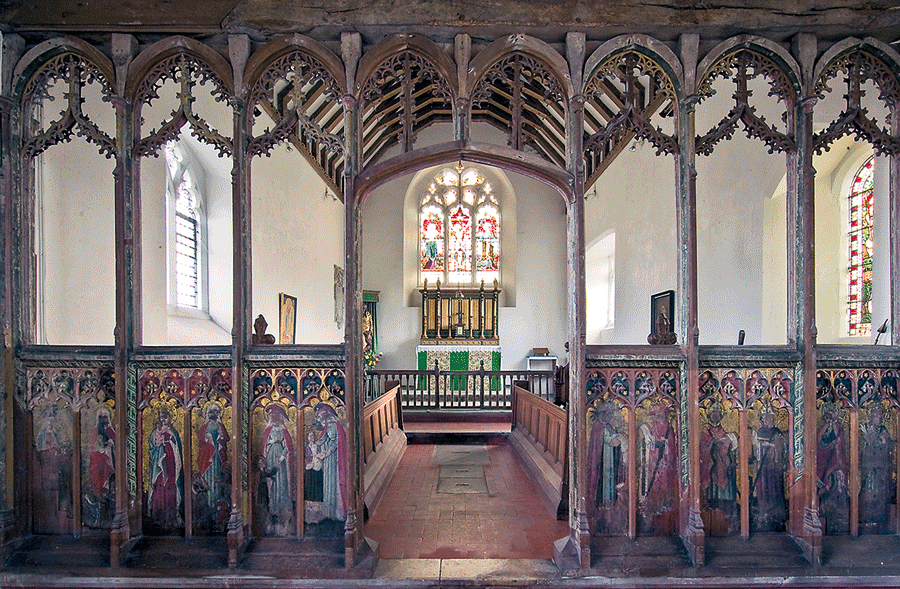
Typical rood screen with solid bottom, open arches, a beam up top, and a Crucifix flanked by St. Mary and St. John
A major architectural feature of many medieval churches across Europe was the rood screen. “Rood” (from Old English, rōde) means “cross” or “crucifix,” and a rood screen is a partition, usually solid to about waist-high with open tracery above, atop which is a large cross or crucifix, that delineated the nave from the quire and Altar. The immediate visual impact of seeing a screen between the nave and the Altar will be one of familiarity to Orthodox of the Eastern Rite.

It would be tempting to say that the rood screen and the iconostasisare cousins with a common ancestor, but like so many relationships between things Eastern and Western, it’s complicated.
The iconostasis developed from a short rail or wall which stood between the Altar and nave, a feature common in churches both in the Western and Eastern parts of the Roman/Byzantine Empire.

Templon with columns in Basilica Santa Maria in Cosmedin, Rome, 8th century
This primitive Altar rail began to have columns placed on top of it, often with a beam or rail spanning the columns so that curtains could be drawn at various parts of the liturgy. These taller rails with columns were called templons.

An example of the ancient Altar rail in the Ravenna Basilica of Sant’Apollinare, built circa 504 AD.
Watch
Rendering of likely templon in Hagia Sophia, Constantinople
Eventually these templons were adorned with images of Christ and the Saints, and in the East, this custom solidified into a tradition which became the iconostasis.

Templon with Icons in Thessaloniki
The fact that iconostases are sometimes surmounted by crosses and rood screens sometimes have icons painted on them again seems to suggest a direct relation.

Rood screen with icons at St. Giles church in Norfolk, U.K.
But here’s the sticky wicket: unlike the templon and later iconostasis, the historic function of the rood screen was to divide not the Altar from the rest of the church, but rather the quire from the nave. In the West especially, the ritual choir was often separated out from the general laity. A striking example of this segregation can be seen in the Basilica of San Clemente in Rome, which has the choir walled off in the center of the nave, to the west of the Altar which is itself separated by a short wall and is under a ciborium.

San Clemente, Rome, with wall surrounding choir (or schola cantorum)
The more usual way to separate out the choristers, however, came to be by allotting them the far east end of the nave and placing a screen of some sort (generally not a solid wall, so that they could still be heard well) between them and the rest of the nave. This screen was often carved with cancelli (Latin for “lattice”), and so the screen became known as the chancel screen, and the area to the ritual East of it was generally called the chancel. More specifically, the area where the choir sung was called (appropriately) by the old spelling, the quire. (Note: “chancel screen” and “rood screen” are sometimes used interchangeably, but it’s the Rood or Cross at the top that properly makes the screen a rood screen).

Rood screen separating quire from nave, altar rail separating both quire and nave from Altar
In the West, the segregation of the choir made more sense because the choristers were generally monastics or ministers, and often were cloistered (meaning they were under vows to be separated out from non-monastics under most circumstances). But not all monastics were clerics or had business at the Altar, so the Altar was still set apart from the area of the quire by a set of altar steps to elevate it and/or by an altar rail.

Front to back: rood screen, quire stalls, altar steps, altar rail, Altar – Coryland Abbey, Lincolnshire, U.K.
Though altar rails were always there, rood screens clearly represented the first and greatest boundary in Western church architecture between the laity and the celebrant at the Altar—ritually speaking, between earth and heaven. Just like there are choirs of angels between earth and the throne of God, so there was a ritual choir between the people and the Holy of Holies. The ritual choir once had a stronger association with those heavenly choirs of angels. And even to reach that heavenly choir would mean traversing the boundary of both death and salvation: through the holy Rood.
With the 16th century Protestant reformation and the Roman counter-reformation, monasticism declined and so did ritual choirs. With the decline of the ritual choirs composed of cloistered monastics and the rise of mixed choirs made up mainly of laity, the emphatic demarcation in the form of a large screen between the choir and the nave seemed less necessary. The Roman Council of Trent also sought to curb clericalism, so as a way of breaking down the figurative walls between clergy and laity, the literal walls/screens came down (interestingly, most rood screens that survived were in ritualistic Protestant areas like England and Scandinavia).
The West, over several hundred years, has now grown accustomed to not seeing many rood screens. Generally an altar rail and steps are the boundary that separates earth from heaven now. This is the case in many Western Rite Orthodox churches. And clearly this has an ancient origin—arguably the most ancient. But I believe the instincts which perpetuated the use of rood screens were extremely similar to those which perpetuated the use of iconostases (even if their architectural development was not entirely congruent), those instincts being to emphasize the mystery of the Holy of Holies. Indeed the functions they ended up serving were very much the same.
I think those instincts can still make good use of rood screens, with or without ritual choirs behind them. The virtues for the rood screen are many:
-
The visual impact of a screen before the Altar is arresting and unarguably indicates a border to the mysterious.
-
Rood screens are often one of the most beautiful features in a church, becoming an invaluable aspect of the church’s aesthetic merit.
-
The theological and ritual symbolism of the Cross (Rood) being at the boundary between earth and heaven in the church is extremely valuable.
-
And for Western Rite Orthodox churches, the rood screen becomes a point of shared experience with the Eastern Rite though, the Western rood screen is still distinct in many ways: displaying Christ on the cross flanked by his supplicating Mother and St. John the evangelist, instead of the Deisis image of Christ on a throne flanked by his Mother and St. John the forerunner; and instead of being solid like most iconostases, rood screens are generally more open so that more can be seen (and heard) through it.
Rood screens in the Western Rite are not required, and a church is not less for lacking one. But they are an extraordinary jewel in the crown of diverse architectural and aesthetic splendors the Church uses for the glory of God and the benefit of her children. And maybe it’s time for more people to re-awaken to their merits.















